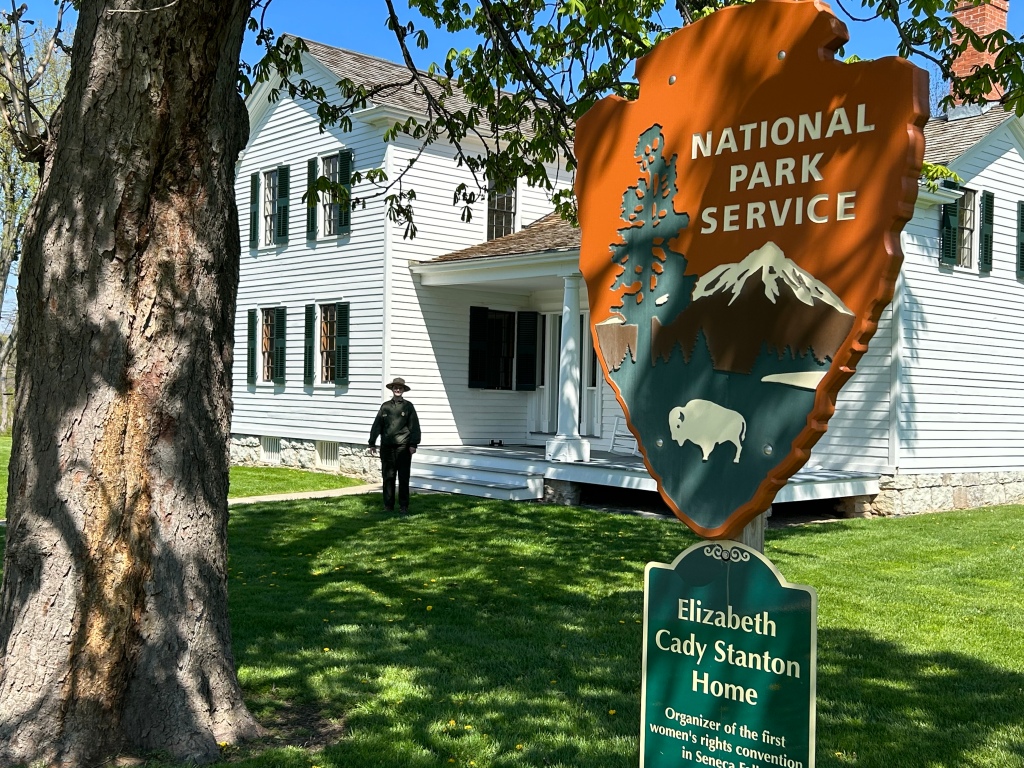
Seneca Falls is a lovely town in the Finger Lakes region of New York, linked by canal to Lake Erie, Albany, New York and the St Lawrence Seaway. Frank Capra modeled his fictional town of Bedford Falls after here, and every Christmas they have events reminiscing about the make-believe story.
When the privileged Elizabeth Cady Stanton settled here with her Abolitionist lawyer husband, she found the real-life industrial mill town full of poor immigrant female laborers and found her own life filled with drudgery, taking care of her many children, while her husband’s career advanced. “How much I long to be free of housekeeping and children, so as to have time to think and read and write.” Starved of the intellectual community she had known in New York, Europe and Boston, she organized a ‘conversation club’ to discuss progressive social ideas, inviting Quakers like Lucretia Mott and Abolitionists like Frederick Douglass to her home above. One day, her friend Amelia Bloomer (who popularized the women’s pants) introduced Stanton to Susan B. Anthony, and together they changed history.
“It has been said that I forged the thunderbolts
Elizabeth C. Stanton of her co-author and friend Susan B. Anthony
and she fired them.”
At the Revolution, many women and people of color had the vote, which was determined by each state. Abigail Adams asked her husband to “remember the ladies” in 1776, but women’s rights were not included. The biggest barrier to voting was neither race nor gender, it was lack of property. White males disenfranchised others by taking control of land, businesses, marital assets, divorce settlements, bank accounts etc., and then requiring minimum amounts of property to vote. Then they started making gender discrimination official. In 1777, women in New York explicitly lost the right to vote. In 1780, Massachusetts women did too. In 1784, New Hampshire women were disenfranchised. When the Constitution was enacted in 1787, only New Jersey women kept the right to vote.
Native American women in upstate New York owned property and had other rights in their Haudenosaunee Confederacy. And African Americans also wanted voting rights. Elizabeth Stanton realized deeply what was happening in America: women were being systematically oppressed. She sought out allies among the Abolitionists, African Americans, Native Americans and immigrant activists, and they began organizing a movement. In London, her husband had been allowed to speak at the Anti-Slavery Convention, but the women were all excluded. In America, this new movement would be led by women. In 1848, at the Wesleyan Chapel, the First Women’s Rights Convention demanded equal rights, including the right to vote. And they began a campaign that continues to this day, from the American Woman Suffrage Association to the League of Women Voters. Many suffragettes went to prison to try to win rights for all women. The 19th Amendment finally passed in 1920, when the last holdout’s mother sent the Senator a telegram, causing him to flip.
The park unit does not do a good enough job of telling the story—with the notable exception of ranger Nicole above. On the plus side, the names and images of numerous women’s rights activists are presented, and many of the related issues are described in the text-heavy exhibits. Sojourner Truth demands inclusion for African American women, “I have borne 13 children, and seen them most all sold off to slavery, and when I cried out with my mother’s grief, none but Jesus hear me. And ain’t I a woman?” FEW Harper puts it well too, saying that white women “need to be lifted out of their airy nothings and selfishness.” There’s a single image of a women’s rights meeting that occurred in Persia (now Iran) one month before the convention here, with a quote from Táhirih, “You can kill me as soon as you like, but you cannot stop the emancipation of women.”
But the park film is no longer available, and replacing it “is difficult”. One of the largest photos shows a female African American military (ROTC?) recruit in front of a line of white uniformed men, without any information or ranger knowledge, thus forgetting the name and act of a woman who apparently broke both a gender and color barrier. More of the exhibits are about the Underground Railroad and fashion than to the right to vote. Frankly, I learned more about the direction and timeline of women’s voting rights from a small display in the parking lot of the XIX Cafe than from the official park exhibits. One of the local women described the whole park as “lame”. It took me two days walking all over town to piece together the story. It is frustrating to see such a missed opportunity to tell the story effectively about the extraordinary centuries long struggle for the basic rights of the majority of US citizens.
But go anyway. Ask to see the park film—they’re counting the number of people who complain. Ask how the history here relates to the loss of voting rights today. Ask about the Equal Rights Amendment. Ask about Lily Ledbetter. Ask about Trans rights and reproductive rights. Ask them to describe the Suffragettes who burned Wilson’s effigy in front of the White House. Make some noise, and don’t let manners hold you back. Don’t let this history die, or future generations will have to fight it all over again. The fight goes on!
Pingback: Harriet Tubman National Historical Park | Zero Carbon Travel
Pingback: Frederick Douglass National Historic Site | Zero Carbon Travel
Pingback: Belmont-Paul Women’s Equality National Monument | Zero Carbon Travel
Pingback: Clara Barton National Historic Site | Zero Carbon Travel
Pingback: Standing On the Shoulders of Giants | Zero Carbon Travel
Pingback: Women’s History Month | Zero Carbon Travel